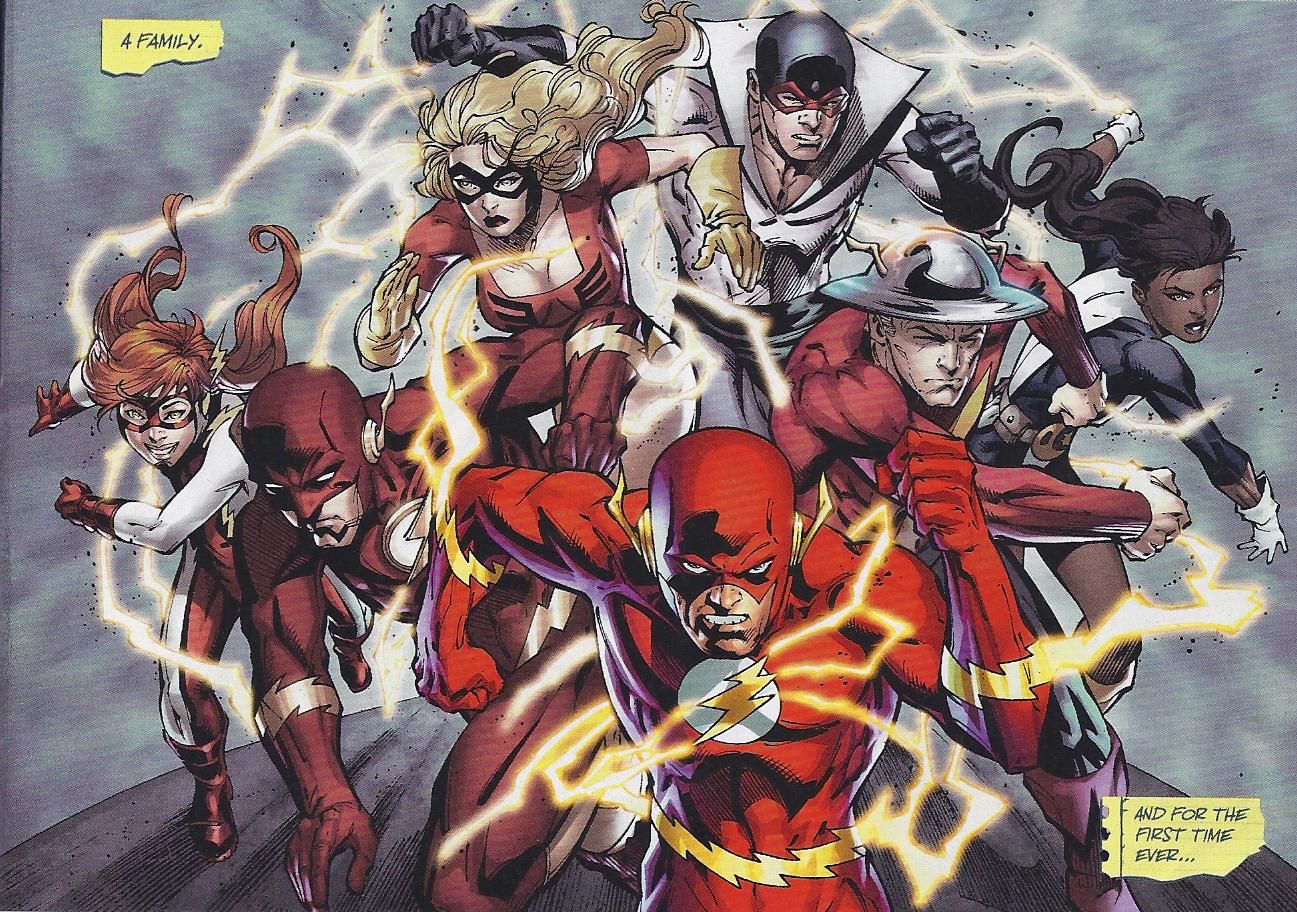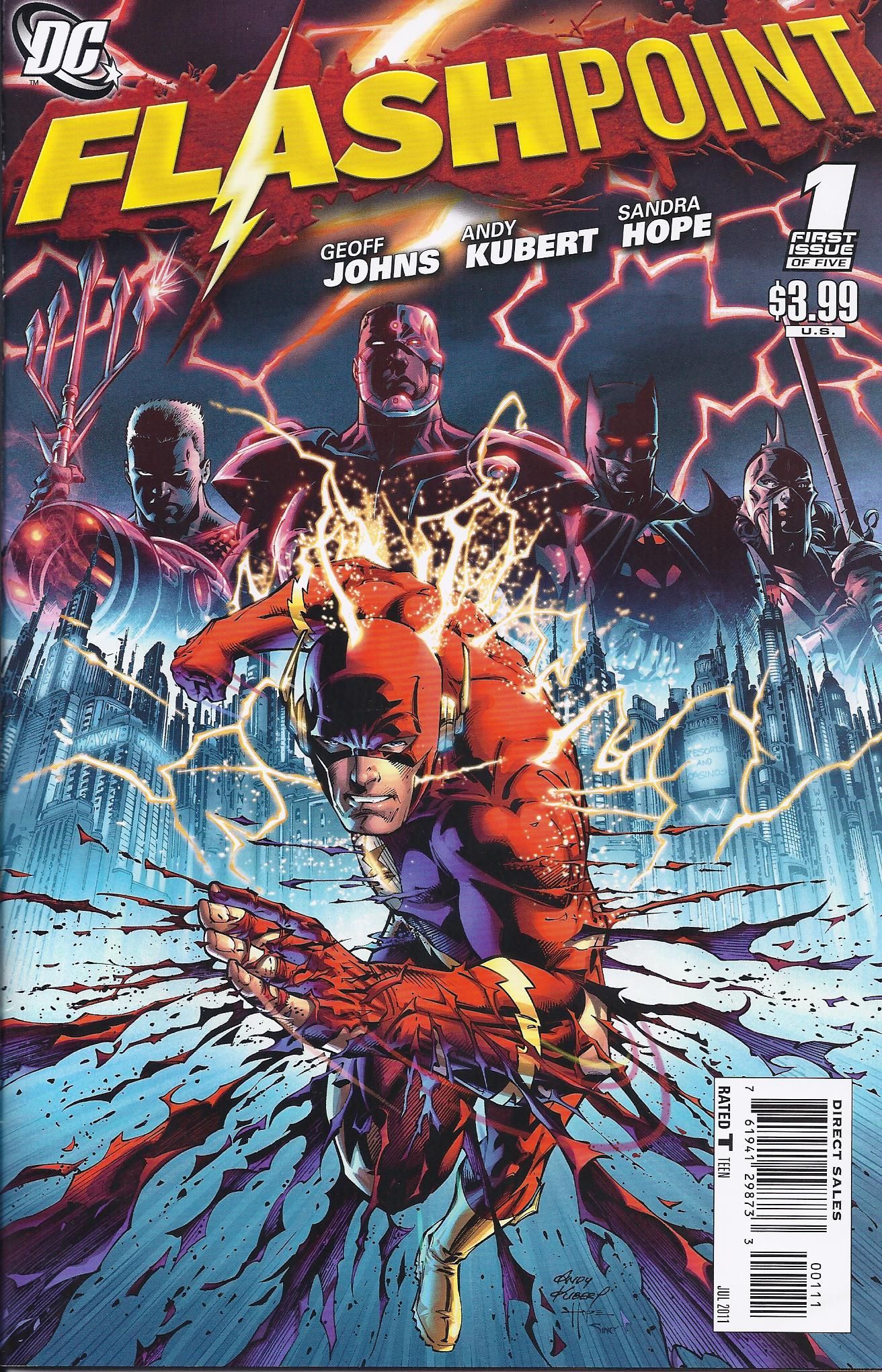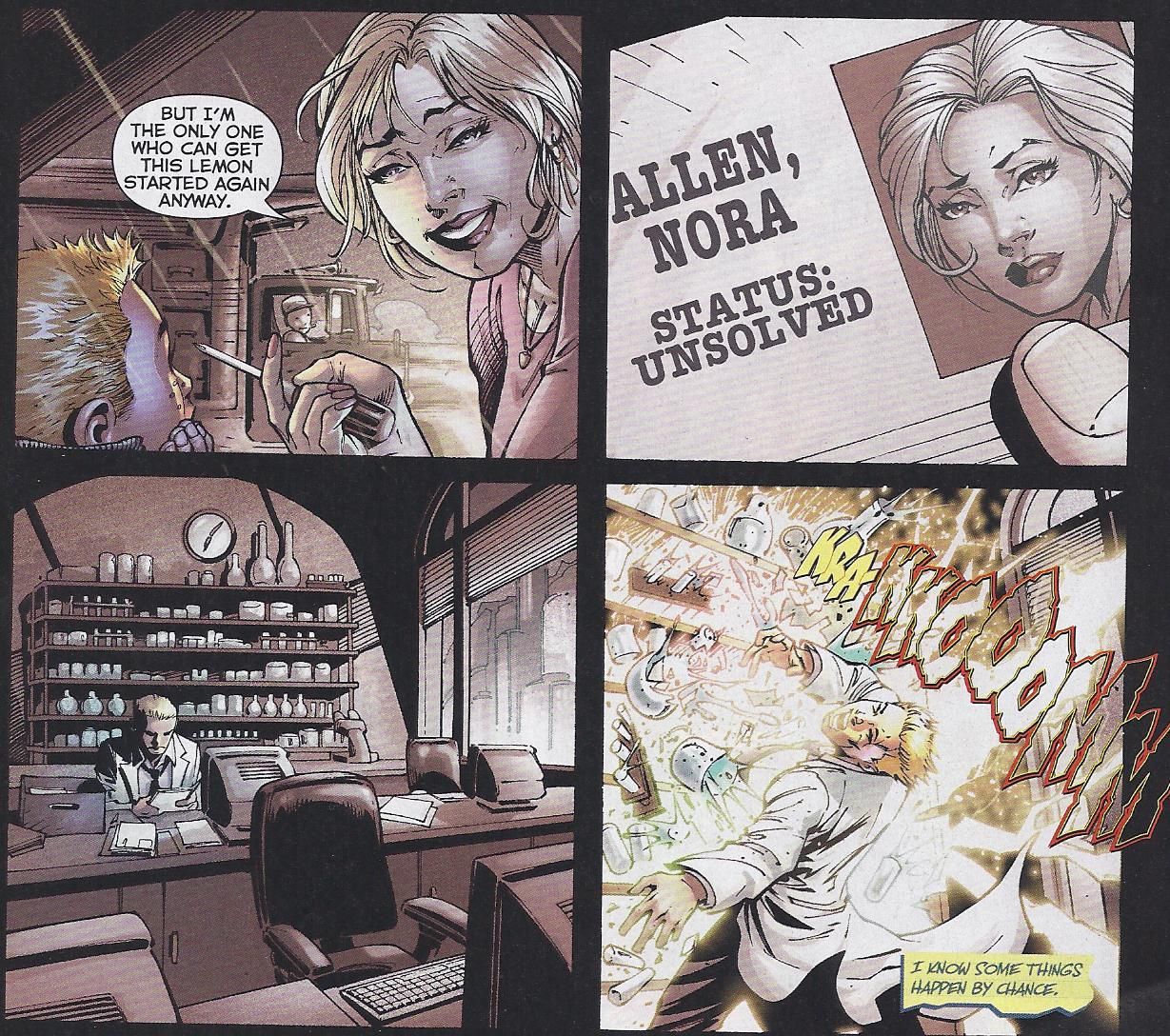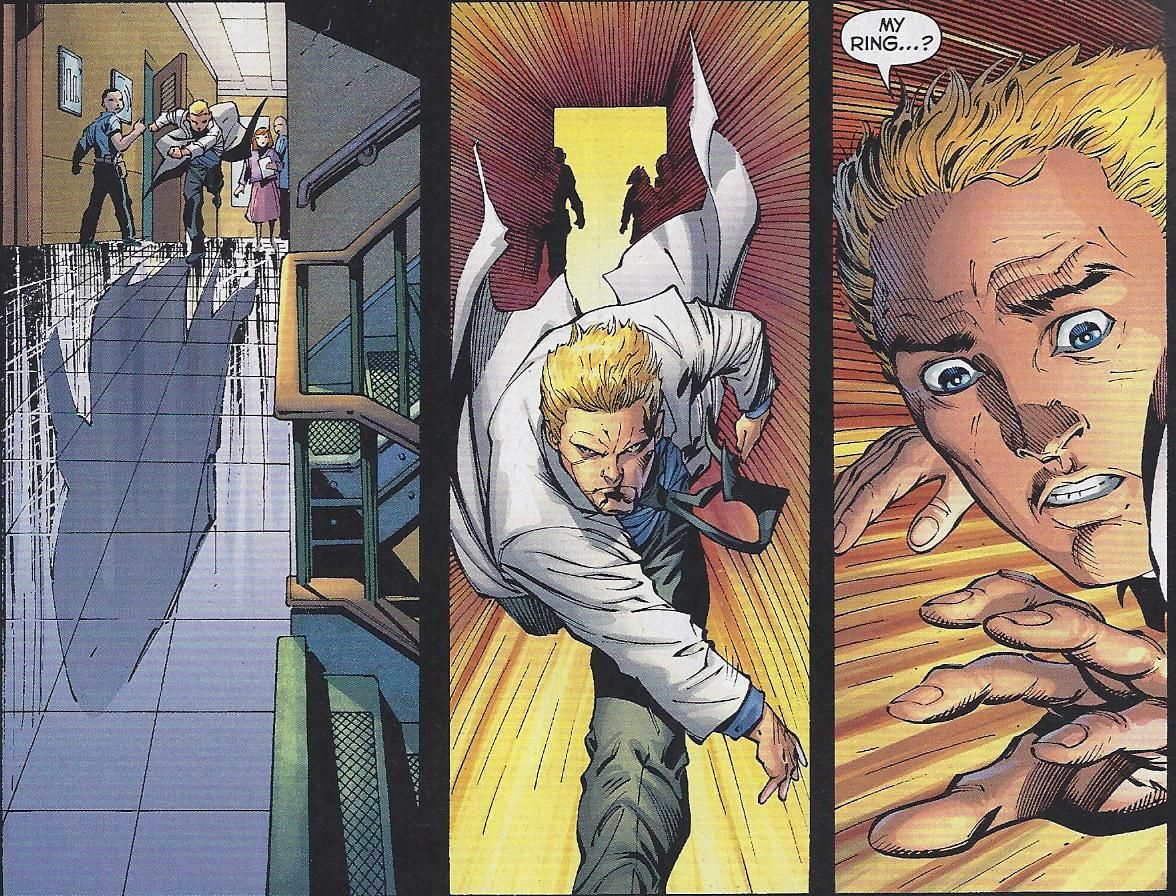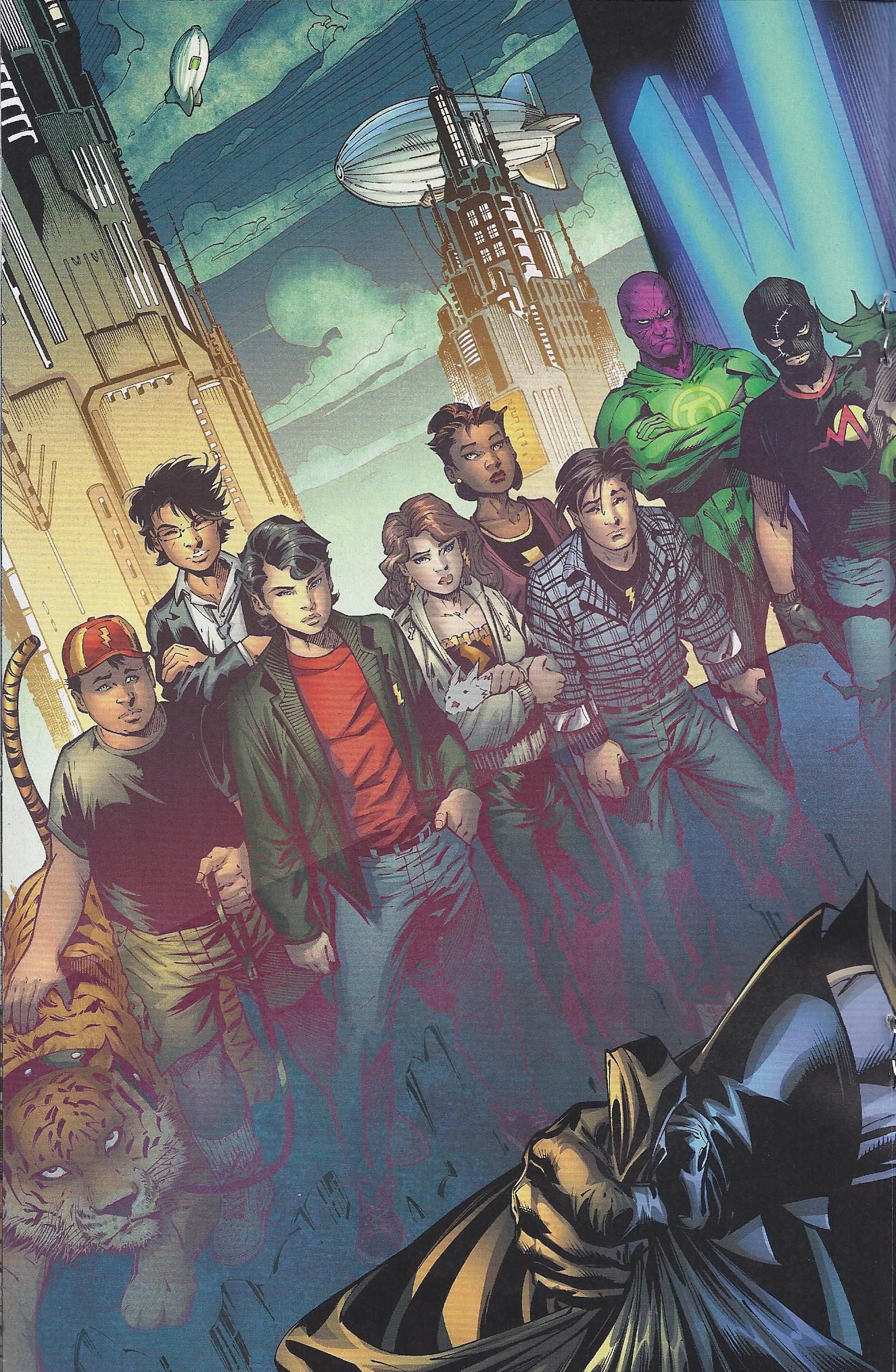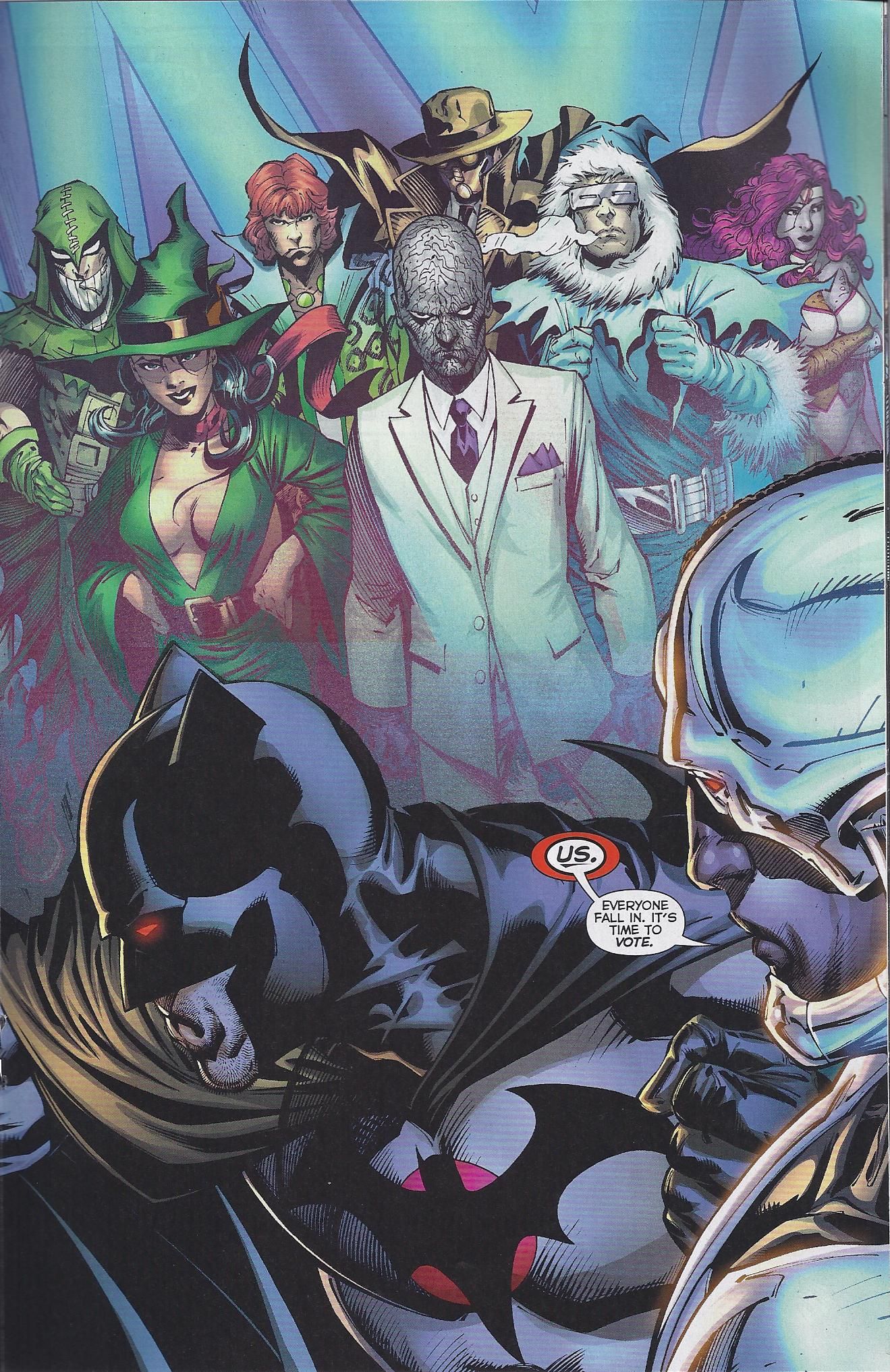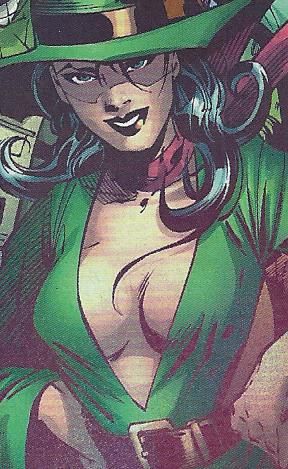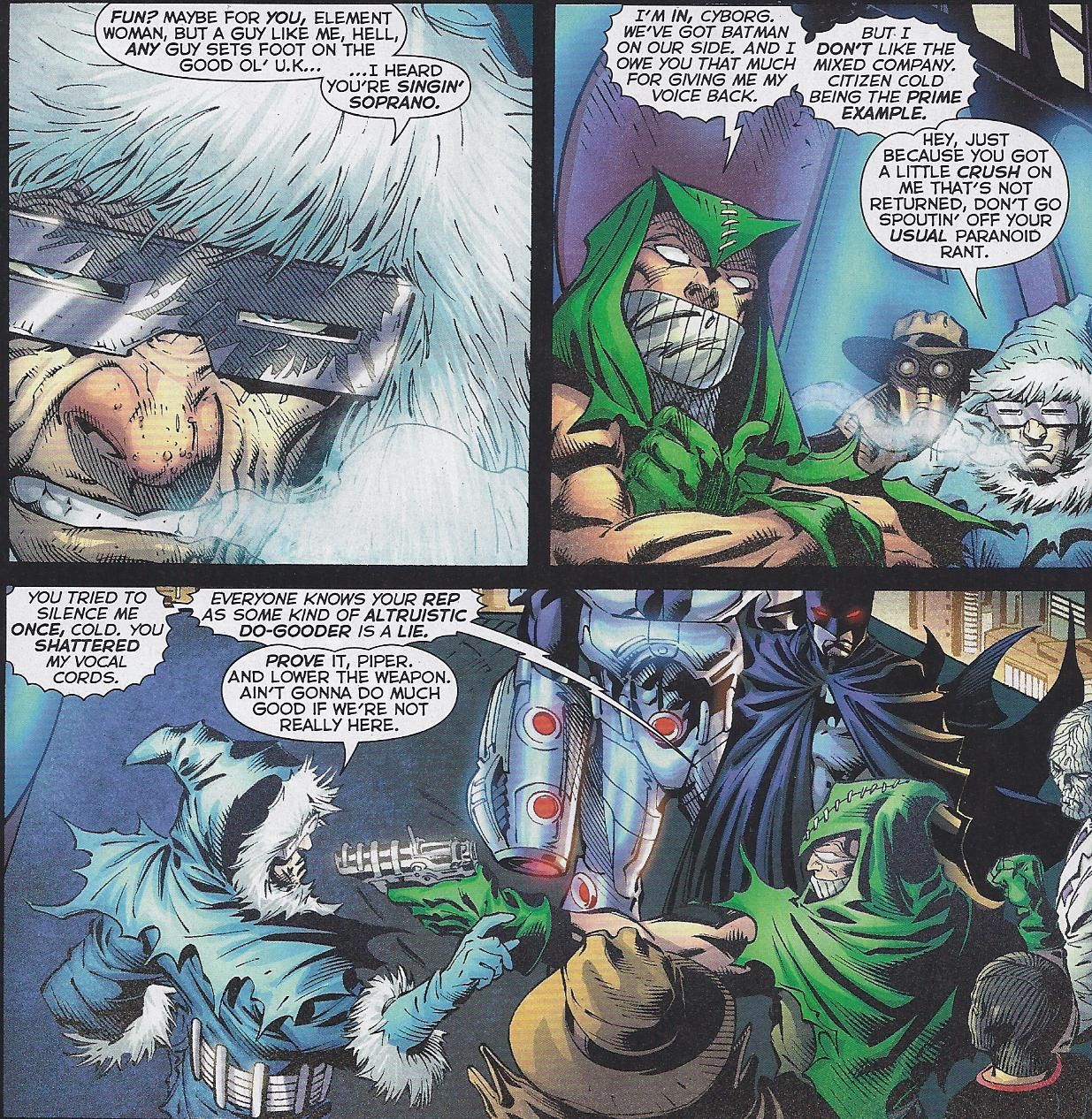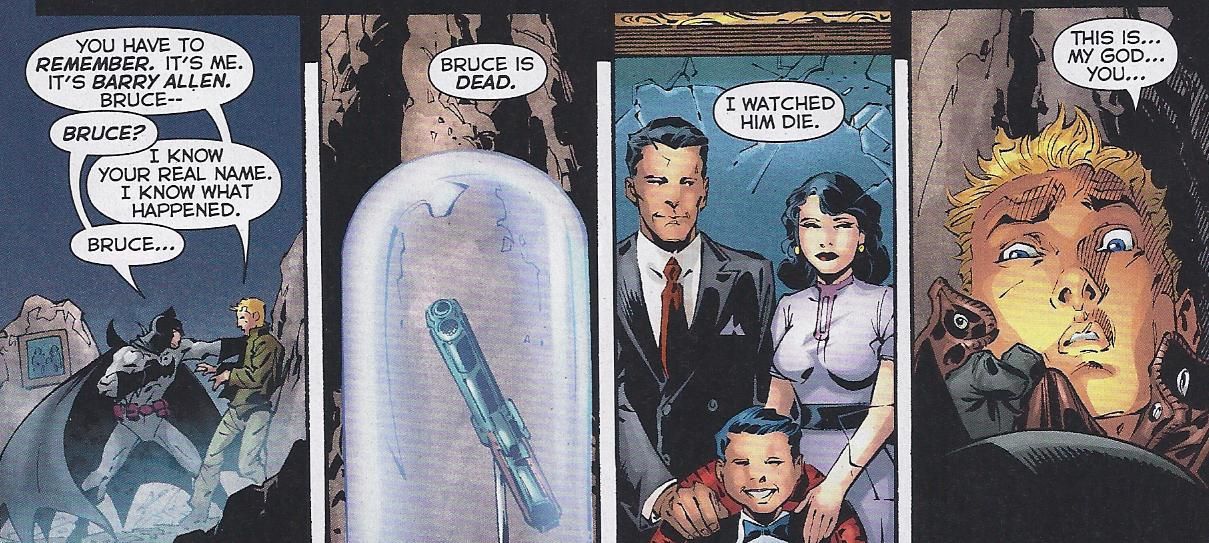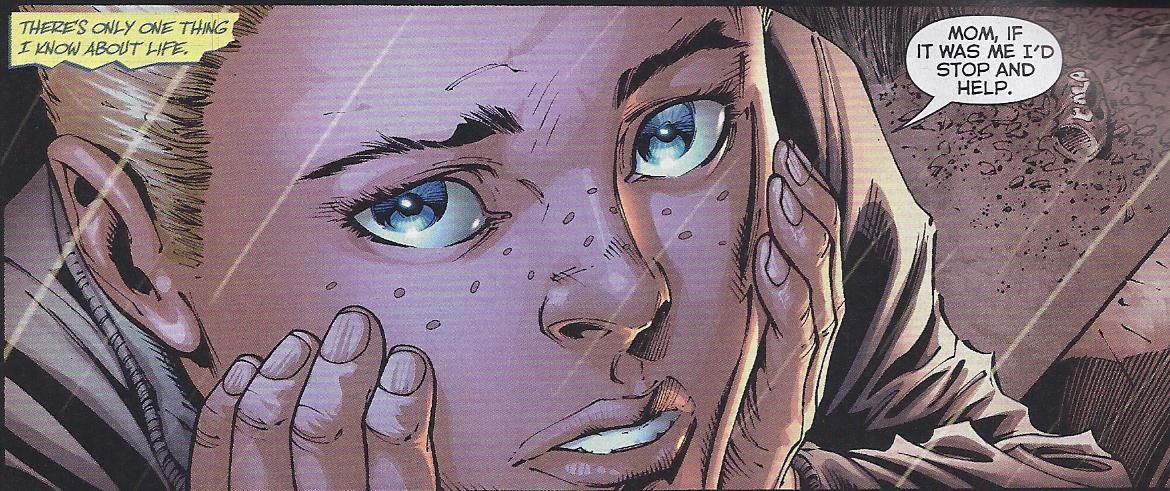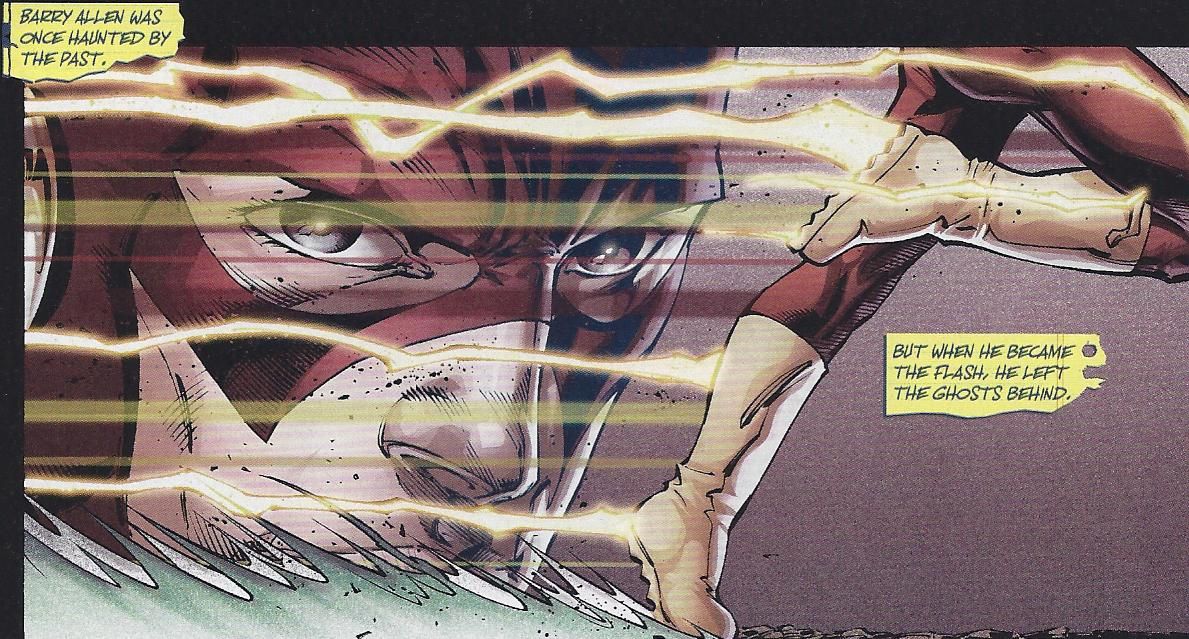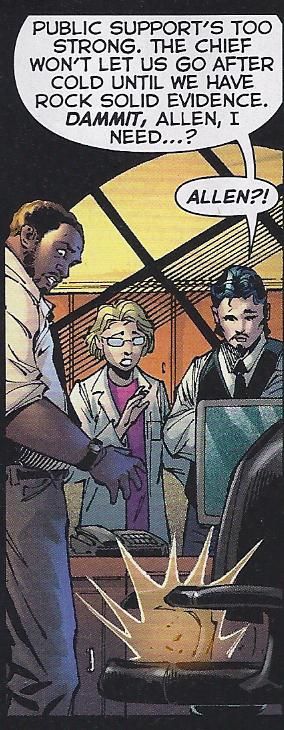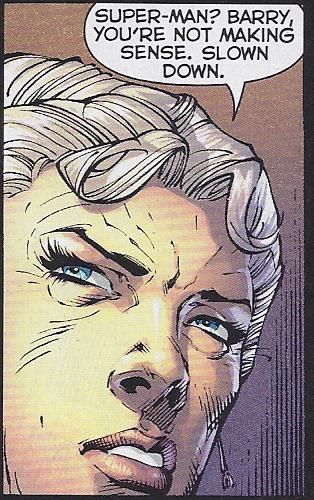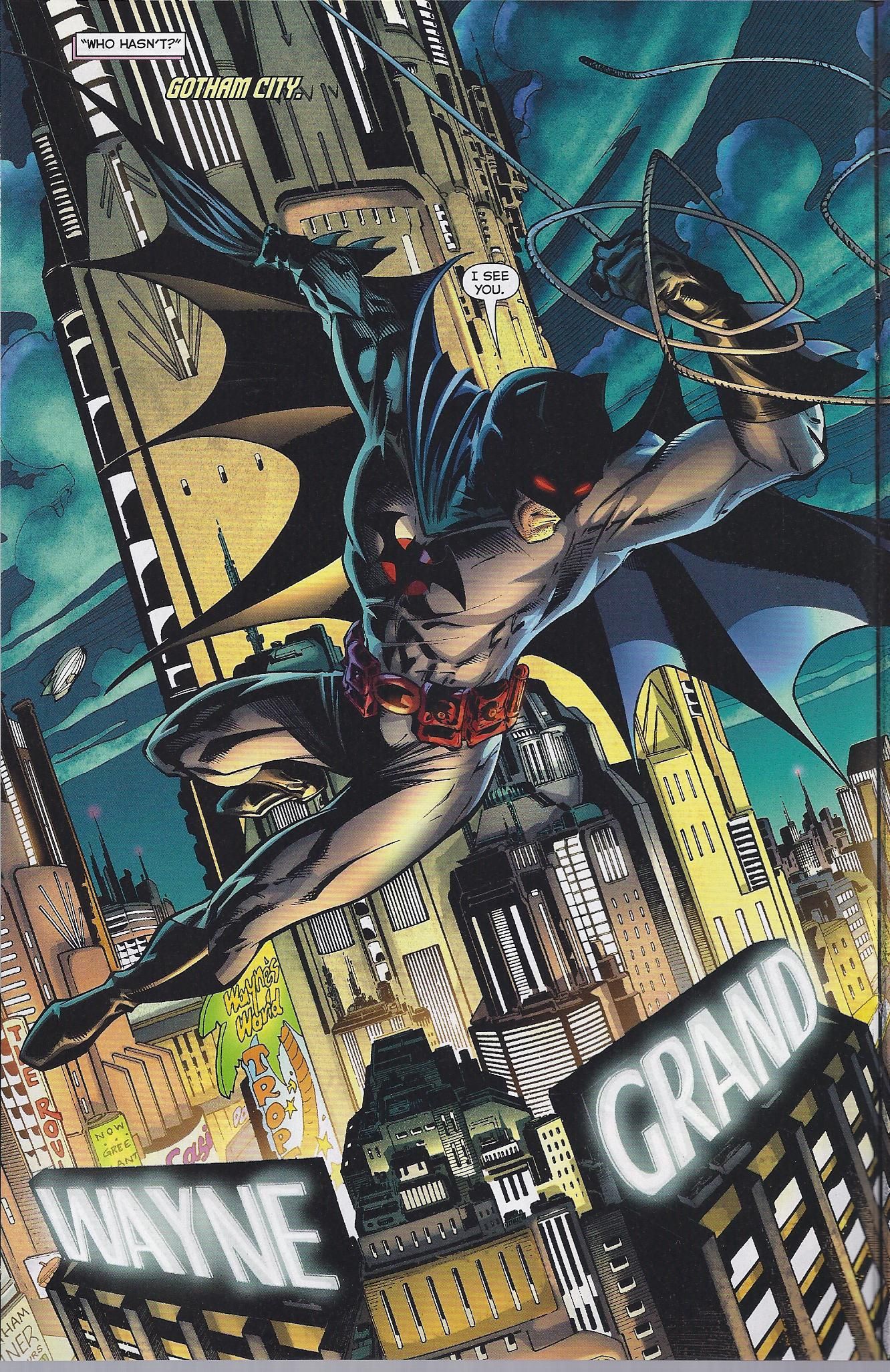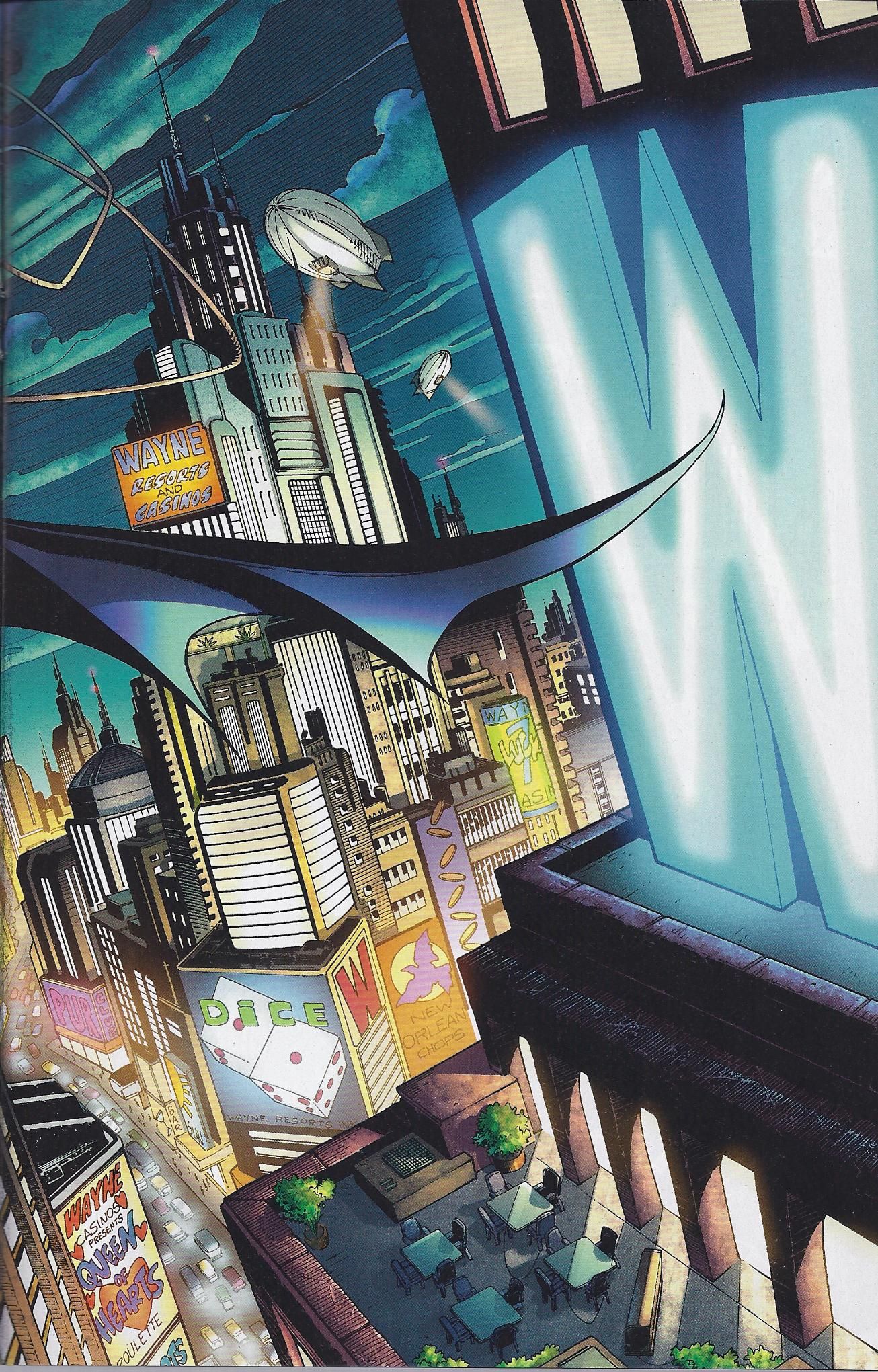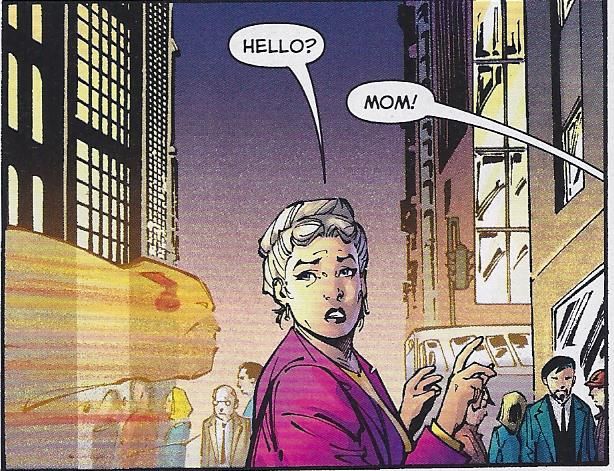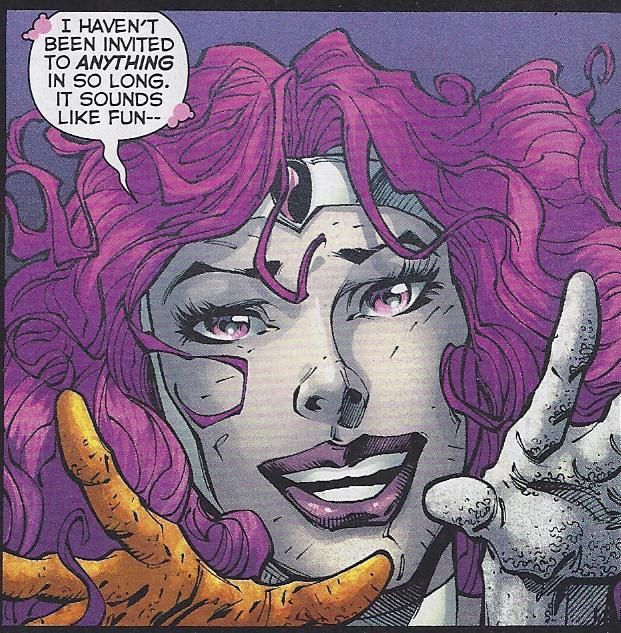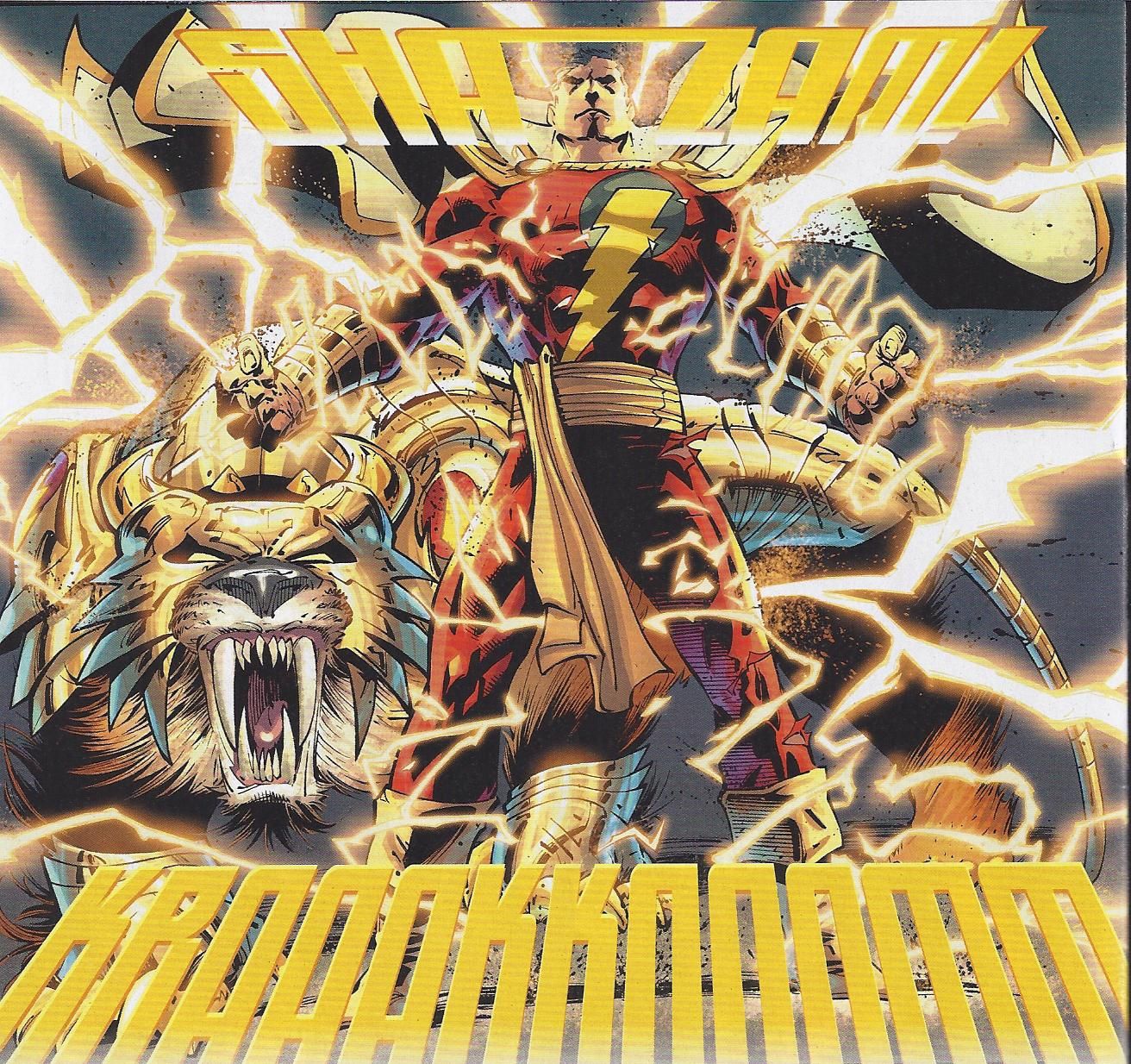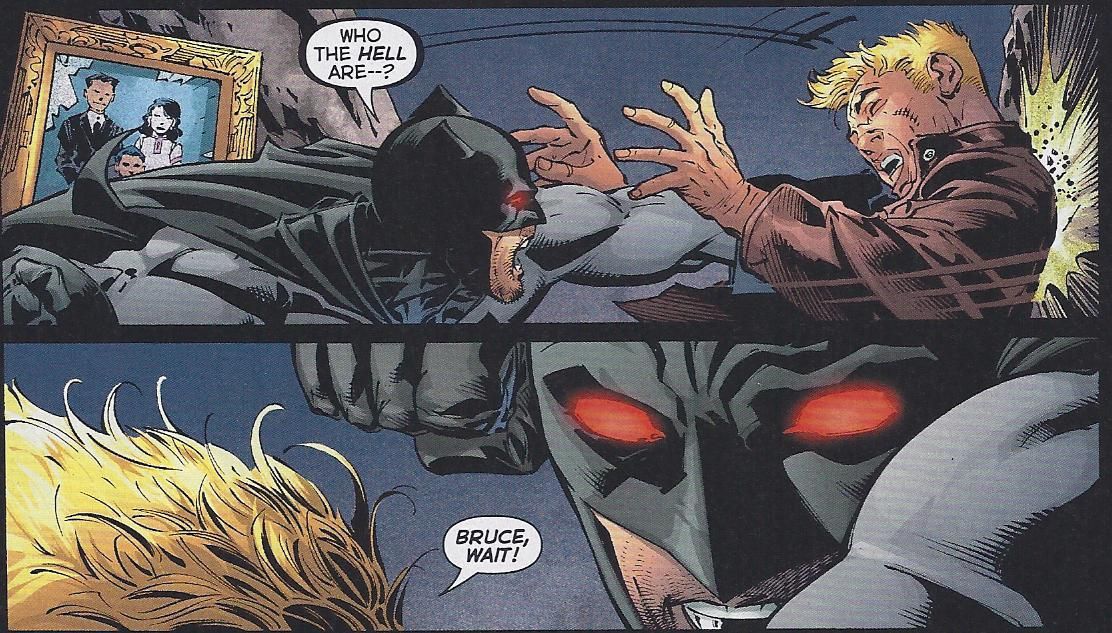It's time the other Big Summer Event got the Burgas Treatment! (Doesn't that sound like some horrible medieval process by which, I don't know, doctors extracted a spleen from the king or something?)
The last time I did this, some people got bent out of shape a bit because they didn't think it was a good review. I didn't make it very clear in that post that I had already "reviewed" it and that post wasn't supposed to be a review - I expressed my opinion about certain things, but I was trying more to examine how Matt Fraction and Stuart Immonen and Laura Martin created the comic rather than whether they did it well or not. The same thing applies here. I am not going to "review" Flashpoint #1, at least not in a traditional way. I will offer my opinion about certain elements of the comic, but that's not the main theme of this post. Much like the post I did about Fear Itself, I want to look at how the creators construct this comic and what tricks they use to do so. I just wanted to make that clear in case anyone lets me know this isn't a good review. I know it isn't. It's not supposed to be. But there are plenty of SPOILERS, so please don't read this if you plan on reading the comic. I can't warn you any more clearly!
This Event Book is a bit different than Fear Itself in that it's set in an alternate universe, so it's not progressing from any existing storylines (although some recent issues of Flash have been advertised as leading up to the event, but I don't know how much groundwork they lay). Like Fear Itself, I'm treating this Event as something a person who doesn't read the core titles involved should be able to delve into. I don't read Thor and I don't read Flash, but as a fairly broad-based comic book reader, I ought to be able to get into the two Summer Events, oughtn't I? So what's the baseline knowledge a reader should have when it comes to Flashpoint?
DC, I think, has more iconic characters than Marvel - meaning characters the general public would be familiar with, even if in a vague way. There's Superman and Batman, of course. I would argue that Wonder Woman and Aquaman are the next two most iconic characters, even if neither of them have ever had much success within the comics world. Even if the general public doesn't know the Flash, his powers are fairly easy to comprehend. Other than that, the only other thing that I think a reader needs to know is Batman's origin. As this is set in an alternate world, the status quo of the DC Universe need not concern us.
Interestingly enough, while the premise of Fear Itself was somewhat vague before the series launched, the premise for Flashpoint is even more vague. DC has been very brief with their descriptions, and all we're really getting is that the world is somehow screwed up and the superheroes have to save the day. Wow, that sounds specific. So going in, all we really know about the series is "DC heroes in an alternate universe." DC is counting on people to pick it up based on three things: A) People really like seeing their heroes in alternate universes; B) People really like Geoff Johns; C) People really like Andy Kubert. Hell, it worked on me, so who am I to question their marketing strategy?
So, Flashpoint #1, by Geoff Johns, Andy Kubert, Sandra Hope, Alex Sinclair, and Nick J. Napolitano. What's up with this sucker? Writing first, then art, just like last time, okay?
Pages 1-5: We begin with a narration caption, because this is a DC comic. It's one of those boxes made to look like someone is writing in a diary, except the diary is a legal pad because the paper is yellow and has the two red lines creating a margin perpendicular to the lines on which people write. We don't know who is "writing" these recollections, but they're about Barry Allen. The first thought of the book, which is split into two caption boxes, one at the top of the page and one at the bottom, is: "There's only one thing I know about life. I know some things happen by chance." This is a fairly typical device in fiction - using words that refer to one thing (in this case, the second statement is juxtaposed with a panel of Barry Allen gaining his Flash powers via lightning bolt, a totally chance occurrence) but also refer to something greater - perhaps the fact that Barry is now in an alternate universe, as we'll see. On the first page, young Barry Allen and his mother, Nora, are stranded on the side of the road when their car breaks down. Of course it's raining, and of course no one is stopping to help them. Barry tells his mom that if he were driving by, he'd stop to help her, and she tells him that she knows he would, but it doesn't matter because she's the only one who can get the "lemon" started anyway (the car looks like a Pacer). We also see that his mother is dead, her murder is unsolved, and that Barry was struck by lightning, which we infer turned him into the Flash (as we see on page 2).
On pages 2-5 we see the Flash running through the city and some of the events of his past. The narration tells us that Barry was once haunted by his past, but when he became the Flash he left the "ghosts" behind. He got married to Iris West and joined up with a bunch of other speedsters (here we see a picture of him with the latest Impulse, Iris; Wally West; Jesse Quick ... I assume; Max Mercury; Jay Garrick; and Speedy Multicultural Lass; none of whom appear in this comic again), and finally, on pages 4-5, we get a splash page of Barry running with a bunch of other DC heroes. Basically, this is simply a brief biographical sketch of Barry in the regular DCU. The narrative captions get a bit darker, as the writer tells us he's not the hero of this story (which usually means he will be) and that he's been corrupted by "unbearable pain" and he has "too much blood on his hands to be called good." The writer is a man with "nothing left to live for" until the day he met Jesus - whoops, I mean, the Flash.
The interesting thing about this opening is how much Geoff Johns manipulates the audience (note, I'm not saying this is a bad thing; good artists manipulate audiences constantly). All comic book writers, I would imagine, have characters they really like, and Barry Allen seems to be one of those for Geoff Johns (not necessarily the Flash, mind you, but Barry Allen). So he provides this oddly messianic version of Barry's "origin." Barry's first words are "Mom, if it was me I'd stop and help." His mother already knows about her son's nature, as she tells him she knows he would. The rain and the cruel nature of the passing drivers make this an even more mawkish scene. What's fascinating is that Nora Allen says she's the only one who can make the car run. That's certainly plausible, but Barry's father is still alive at this point, and while I wouldn't want to be stereotypically chauvinistic, I find it interesting that she's the mechanic in the family. I can relate, because my wife is much more mechanically inclined than I am, but usually in simple Rockwellian comics like those that Barry Allen tends to inhabit, the parents of characters, especially, fit into fairly standard gender roles, unless one is dead. It seems like Johns is not-so-subtly introducing a resolved but non-violent Oedipal conflict - Barry's father is still alive at this point, but he's somewhat neutered, and Barry is gazing longingly at his mother as she indulges in a traditionally masculine endeavor. Johns is simply setting up the scene later when Barry is reunited with his mother in the alternate universe, but it's fascinating how much iconography and symbolism is on just this first page.
Pages 6-7: This is a strange way for Johns to get into the main part of the story. A man named Forrest, whom Barry knows, wakes him up when he falls asleep on his desk. I very much doubt that Johns would go with the "This is all a dream" mode of storytelling, but the way this particular issue is structured, it's hard to avoid. Are we supposed to believe that this is the "real" world and Barry has been dreaming his adventures? Given that the DCU exists, that can't be what Johns is going for. The only answer left is that Barry is dreaming this world, which won't be the solution because I refuse to believe that Johns would do that. Barry himself, while wondering why he's not the Flash anymore, seems to accept this world rather readily, at least in this issue. So this is a strange way to begin the basic plot.
Anyway, Forrest exposits that they've been pulling 18-hour shifts to solve "Miss Alchemy's" murder, even though Barry doesn't know who that is. His boss, a man named Singh (who's apparently a very westernized Sikh), storms in ranting that they know who killed Miss Alchemy, and all they need is evidence that it was "Citizen Cold," whom Barry thinks is Captain Cold of the Rogues. Of course, nobody knows who that is. Just then a call comes in that Citizen Cold and the Pied Piper are engaged in a shoot-out, but Singh says they can't go after Cold until they have evidence, and so he turns to Barry ... who's not there. He, of course, has leapt into action as the Flash, but as he reaches the steps, he realizes he's not wearing his ring and he trips and falls down the staircase. Oh dear.
This is a somewhat minor item about the Flash that a non-Flash reader might not know, that Barry keeps his Flash costume in a ring on his finger (how it expands and contracts I will leave to the Flash aficianados in our midst). So the fact that he doesn't have a ring on might be less dramatic if you have no idea what he's talking about. Suffice it to say, he's not the Flash.
Pages 8-11: When he reaches the bottom of the steps, someone says his name. He looks up and sees his elderly mother standing over him. He, of course, is rather surprised to see her, as he thought she was dead. He wonders what she's doing there and she tells him it's her birthday and he promised to take her out for dinner. For some reason, the fact that it's her birthday feels significant, as does the entire presence of Barry's mother in this story. I don't know if Johns will do anything with it, but we'll see. She also makes reference to the fact that she's always on time, an Easter egg referencing Barry's predilection for tardiness, due to the fact that he's often out fighting crime instead of showing up for dates with Iris. We get an emotional scene in which Barry hugs his mother, but when they leave the police station, Barry starts questioning his mother. She tells him that Barry's dad died of a heart attack three years ago, and she's never heard of the Flash or the Justice League or Superman. She has, however, heard of Batman. Interesting ...
Pages 12-13: Johns introduces the Batman of this alternate world. I'll get to the art later, and this double-page splash is pretty much all art. Moving on!
Pages 14-19: Batman is chasing a villain called Yo-Yo across the roof of a Wayne Casino. She is, apparently, a henchman of the Joker, and perhaps fills the Harley Quinn role for that universe. Yes, there is a Joker in this other world. He wants to know where the Joker is, and she gives him a song and dance about the Joker being in all of us, because we're all a bit crazy. Then she says it's on the tip of her tongue, so he retorts, "Then let's get it off" while brandishing a nasty little blade - this Batman isn't afraid to get really violent, apparently. He cuts the lens of her cool wraparound sunglasses as he exposits, "Judge Dent's twins were kidnapped last night. I know the Joker has them. Where are they?!" She tells him that it's too late, because they're probably already dead. He replies, "Then so are you" and tosses her off the roof. Frank Miller wants his royalty check!
She doesn't die, however, because out of nowhere, Cyborg catches her. We know it's Cyborg because she calls him Cyborg. After he puts her down for the cops to pick up, he leaps, from a standing position, straight up the side of the building and lands extremely softly on the edge of the roof. Batman is at least ten floors up (and probably more like 15), yet Cyborg makes the leap easily. Wow. Batman tells him he should have let her hit the ground, which Cyborg ignores. He tells Batman that he always chases the bad guys to the ledge of this particular alley, a reference to the fact that it's where his family died. Batman claims she slipped, and Cyborg points out that "a lot of them slip," but then insists he's not there to judge Batman, but to ask for his help. When Batman asks who needs it, Cyborg reveals a hologram of a bunch of characters from this DCU, ones who will star in various spin-off mini-series over the next few months. Here they are:
The six kids apparently each possess one of the SHAZAM powers that were given exclusively to Billy Batson in the regular DCU. The purple-skinned dude is Abin Sur, the Green Lantern who gave his ring to Hal Jordan when he died, so Hal Jordan is obviously not the GL of Earth. The dude with the stitched-up hood is named Farooq, also known as Blackout. He's standing next to a dude in green with a mask covering the lower half of his face. This is the Piper, who was named as having a gun battle with Citizen Cold, seemingly five minutes before (although Barry's reunion with his mother might not be happening at the exact same time as this, even though Johns uses her narration as a transition from Barry to Gotham). The babe whose boobs (or, as my Polish grandmother used to call them, "bubs") are hanging out is the Enchantress. Seriously, how do those things stay in? In the back is Shade, the Changing Man, who's next to this Earth's version of Wesley Dodds - he gets only one speaking panel and we don't know if he's even called Sandman or if it's Wesley Dodds, but let's go with it. In front of him stands the Outsider. Citizen Cold stands behind the Outsider's left shoulder, and the girl on the far right is Element Woman, a young lady named Emily Sung (she doesn't look even vaguely Asian, though - maybe it's her married name?). Batman looks unimpressed to see everyone.
Pages 20-21: Barry and his mother are standing in front of the offices of the newspaper the Central City Citizen, and Barry says he needs to talk to Iris, who of course his mother doesn't know. Barry still hasn't gotten the hint, so he goes into the offices anyway. Of course, she's not "Iris Allen" but Iris West, and as Barry's trying to find her at the receptionist's desk, she comes strolling out with an editor, who's telling her the assignment she wants is too dangerous. Johns gives us some information about this world - Iris says that Lois Lane is already behind enemy lines and someone from the Citizen needs to tell the world what's happening in Europe. Before Barry can call out to her, someone named John gets her attention, tells her that what she's trying to do is crazy, makes a reference to her "nephew" (which means we'll see Wally at some point, I suppose), and starts macking on her, much to Barry's surprise and dismay. Down on the street, Nora Allen hears a voice that says, "How nice to see you alive and well, Mrs. Allen," but she doesn't see anyone. We do, however - a blurry flash of yellow and red that shows the presence of Professor Zoom. This is the only place in the comic that someone who isn't familiar with the regular Flash series might be confused. Obviously, as this is a serialized story, we'll find out more about this mysterious voice and blur later, but Johns obviously wants us to get immediately that it's Professor Zoom, as that will make readers say, "Oh, he's behind it somehow!!!!" and not just assume Barry's dreaming. Even if you're not familiar with Professor Zoom, it's obvious something weird is going on here and it's someone who knows that Barry's mother ought to be dead. When Barry rejoins his mother, he asks to borrow her car. To the Old-Woman-Mobile!
Pages 22-29: We're back on the roof of Wayne Casino, and it's time for a big-ass info dump regarding this Brave New World we're in. One of the SHAZAM kids drops a clue when he says that Batman is "older than [he] thought." Remember that, good readers! Cyborg explains to Batman (but really to the readers) that Atlantis sank Western Europe into the ocean while the Amazons took over the United Kingdom and both Aquaman and Wonder Woman want to rule the world. Cyborg needs allies to stop them, and he asks Batman and the holograms (soon to be performing their greatest hits from the '60s at a venue near you!) if they'll help. The first person to step up is Element Woman, who doesn't seem like she's all there. Citizen Cold points out that if any man steps foot in Britain, the Amazons will castrate them. The Piper owes Cyborg for repairing his shattered vocal chords, vocal chords that Citizen Cold shattered, which kind of makes this meeting awkward. The Piper repeats the earlier contention that Cold isn't the do-gooder he appears to be. Farooq, the kid with the black mask, tells Cyborg that he shouldn't ask him to fight alongside the Outsider, because the Outsider has been hunting him for months. The Outsider exposits that Blackout is the "cleanest and most powerful source of electricity on Earth" and that any country would benefit from plugging him in. The Outsider implies that he's from India, but I suppose we'll see. He admits that the war is bad for business, so he's in. So is Cold. The Sandman says he dreamt about this in the late 1930s, so he's in. Abin Sur says if it's jake with the guardians, it's cool with him. Element Woman chimes in again, prompting Enchantress to tell Shade that Element Woman would volunteer for anything, which allows Johns to introduce Shade's meta-vest and the fact that he can sense madness. Cyborg asks Shade about the "Secret Seven," to which he and Enchantress belong, and while Enchantress says no, they take a vote and five invisible people vote, with the "yays" beating the "nays" 4 to 3. The SHAZAM kids vote too, and we learn that Tawny the tiger can't speak (unlike his DCU counterpart), and his pal is named Pedro. The one names Billy has the courage of Achilles, while Freddy possesses the power of Zeus. BillyFreddy also makes a Star Wars reference, which made me grind my teeth a little bit, because it doesn't seem pertinent and it would have been interesting if, in this world, Star Wars never got made and nerds everywhere were making references to something really cool, like Manimal. One of the girls in the group is Mary, while the other is named Darla (really?). The boy named Eugene, who has the wisdom of Solomon, says they should ask Captain Thunder, so they say Shazam, turn into the superhero (and the tiger gets a makeover as well), and Thunder says he's in. Apparently Wonder Woman scarred him up right good, and he wants to return the favor.
With everyone in, Cyborg begins to talk about a plan, but Batman wants nothing to do with it. He says that Cyborg doesn't stand a chance, mainly because once all the "allies" get in a room together (remember, they're holograms right now), they'll kill each other. He leaves, and because many of them joined only because Batman was going to be part of the group, Cyborg's "Justice League" falls apart quickly, leaving him alone on the rooftop. So sad!
Pages 30-34: Barry drives into Gotham City and finds an abandoned Wayne Manor. He enters the Batcave and looks around. He sees the gun that killed the Waynes in a glass case. He sees a portrait of the entire family in happier times. Then the narration that we saw in the beginning comes back, with the lines "The first time I met Barry Allen, I nearly killed him" as Barry turns when a hand is placed on his shoulder. So Batman is our narrator, which is useful to know. Batman flips him over and grabs him, ready to punch him out, while asking him who he is, but Barry says, "Bruce, wait!" Barry tells him who he is and that he knows his real name, but Batman says that Bruce is dead, which is when Barry realizes that Batman is actually Thomas Wayne, Bruce's father. Dum dum DUMMMMMM!!!!!! So ends issue #1.
Okay, now let's get into Andy Kubert's art. Sound good?
Cover: Flashpoint #1 features a pretty strong cover, with the Flash running in the foreground and the four principal heroes in the background - Aquaman, Cyborg, Batman, and Wonder Woman. In between we see Gotham City, which I suppose is going to be important in this story. It's a good mix of kinetic energy (from the Flash) and portentous looming (by the others). Flash's costume shredding must imply the fact that he has entered an alternate world where he's not the Flash. I guess?
Pages 1-5: If we return to the slightly messianic bent to the first page, let's consider the first panel of this comic book. Barry Allen looks lovingly up at his mother, and his eyes are piercingly blue and a tad bit larger than they should be. This ties into the image later of his eyes seeing his dead mother resurrected, and it's interesting because I doubt if this was conscious by Kubert. Johns has proven throughout his career that he likes nothing better than characters he read about when he was a kid, so his adoration of first Hal Jordan and now Barry Allen isn't surprising, but I doubt if he explicitly told Kubert to draw Barry with such deep, soulful eyes. In panel 3, a truck driver looks out his window at Nora Allen and her son. For some reason, it appears like he's smiling. What a dick!
Page 2 is an odd full-page splash. Barry runs along a very narrow creek in a park in the middle of Central City. In the background we see the skyscrapers rising into the sky, while by the creek, an old man sits and fishes (his hat is flying of his head because Barry is causing wind as he runs by) and kids buy ice cream from a vendor. It's supposed to evoke an idyllic scene from the Silver Age, with its mixture of sleek modernity and nostalgic rural life. Page 3 shows a side view of Barry running, his wedding, and his group of speedsters. The first panel bugs me. Barry's right leg is raised in the air, bent at the knee and under his torso, with the heel almost touching his ass. His left leg looks almost as if it's dragging along the ground, because the "speed lines" stretching behind his toe looks unbroken, as if it's never left the ground. Showing someone running seems to be one of the hardest things to do in comics, and this panel shows why. I very much doubt if Barry's right leg bends that high when he's running. It looks very odd.
Pages 4-5 are the big splash page and the credits. Alex Sinclair has been coloring this book strangely so far - the first and third pages are a bit muted and even slightly sepia-toned, which is comic book/movie/television grammar for "taking place in the past," while the full-page drawing of Barry running on the creek is fully colored. So are pages 4 and 5. After this, of course, the point is moot, but I wonder why he chose that palette for two pages of the first five but not the others. Anyway, this again shows Barry running in the same manner - his right foot almost touching his posterior and his knee bent all the way, and although he's the speedster, he's still not in front of Aquaman, Wonder Woman, and Green Lantern (who's flying, but still). It's almost as if those three characters are going to be very important in the alternate world of Flashpoint! The other characters are your standard DC roll call: Jon Stewart, Hawkwoman, Firestorm, Hawkman, Mera, Batman, Cyborg, Atom, Superman, Captain Marvel, and J'onn J'onzz. Superman is as big as the Flash and Cyborg, which seems significant.
Pages 6-11: Andy Kubert does weird things with "speed lines" in this comic. I mentioned the way Barry is running, and on page 6, we see a police car pulling away from the station and apparently kicking up some dirt as it peels out ... on a paved parking lot. I'll get back to that. In panel 7, the last one on the page, everyone looks at Barry's chair when Singh speaks to him, but Barry is already gone, having run off to become the Flash. In his place Kubert draws a burst, in the manner of goofy cartoons:
It's bizarre because we can see that Barry is gone, and I don't know if Johns and Kubert don't trust us to realize that his chair is now empty. It really makes this a sillier comic, and that's definitely not what Johns and Kubert are going for.
When Barry falls down the stairs, his mother is there for their dinner date. On page 8 we see his eyes again, reflecting his mother, who he believes has returned from the dead. This links back to the opening panel, of course, when his eyes were loving; here they're shocked. You'll notice, of course, that Nora has blue eyes as well.
On page 11, we see another police car leave the parking lot. Again, this is a very strange panel. The car roars away, smoke pouring from its rear and what appears to be dirt flying from underneath its tires. I get that there would be a little bit of gravel on the road, but it looks like the car is driving away on a dirt road somewhere in the country rather than on a macadam-paved street in the middle of a city. Kubert wants to show that the car is speeding away, but it seems like a weird way to do it. Kubert does a couple of nice things on this page. When Barry tells Nora he's the Flash in panel 2, his face is grim, his mouth is tight, and his eyes look almost evil. It's as if his secret is being forced out of him, which in a way it is. In panel 5, when Nora tells him he's not making any sense with his superhero talk, Kubert makes her look genuinely fearful for his sanity. That's pretty cool.
As this is a nitpicky post (some people got on me when I wrote about Fear Itself, saying I was too nitpicky, but that's kind of the point of these posts), I should point out the bottom panel on page 11. Nora wears a ring on the index finger and her middle finger of her right hand, but not her ring finger. On page 8, we saw that she was wearing a ring on her pinky on her right hand as well. So she has rings on the index, middle, and pinky fingers but not the ring finger. My mother, who is 67 years old, says she doesn't know anyone who wears rings like that. Maybe my mom is square, but it seems very odd that Kubert would put rings on those fingers of Nora Allen.
Pages 12-19: The double-page splash on pages 12-13 is a pretty nice drawing. We have the ubiquitous blimps that always appear in every alternative world and future and past that has ever existed - if blimps are so cool, why didn't they take off in this world, I'd like to know. Batman dominates the scene, of course, as he swings in from the left looking down at the rooftop where Yo-Yo is running away from him. He has a smaller bat on his chest over a red circle, a red utility belt, and red eyes. He also doesn't shave that often, because unshaven men are s-e-x-y! If we accept that this is the exact same time as in the "real" DCU, Thomas Wayne has to be at least 50 years old, right? I mean, Bruce was, say, ten when his parents were killed. If the "real" DCU Batman is around 30, that means it's been 20 years since that event. Thomas Wayne had to be at least 30 years old when Bruce was killed, right? All I'm saying is, he looks pretty good for a dude who's at least 50 and probably a bit closer to 55 or 60. Gotham City is a gambler's paradise, as Wayne Casinos dominate the landscape. In the bottom left, "Green Lantern" is appearing in some show, and I wonder if the "Pur Club" in the bottom middle means we'll see a version of Selina Kyle in this series.
On page 16, Kubert draws ghost Cyborgs to show how Vic leaps down to catch Yo-Yo. We don't know where he comes from, so it's kind of strange to see him flying sideways from the upper right of the panel to bounce off a wall and land on the ground, where he catches Yo-Yo. It doesn't feel like he would have much momentum that way.
Kubert has some fun with the big hologram display of the reluctant allies on pages 18-19. Everyone looks deadly serious, of course, but Element Woman is looking off to her left, worried. It's a nice touch because, as we find out, she's not quite all there. The SHAZAM kids all have a lightning bolt accoutrement - Pedro's is on his baseball cap, Eugene's is ... somewhere (we can't see it), Billy's is pinned to his lapel, Mary has bolt earrings, Darla has one on her shirt, and Freddy has a necklace with a bolt on it. Nice touch by Kubert/Johns. Enchantress doesn't want to join the team because then she might have to put on a bra.
Pages 20-21: When John presumably plants a kiss on Iris, Kubert shows Barry in extreme close-up on page 21, panel 3. This is a very odd choice. His face isn't even centered in the panel; it's slightly off to the right. Kubert draws his eyes very wide and his mouth hanging open slightly, but the pose is lacking a bit in shock or even surprise. First of all, Barry already knows that something is very weird about this world, and if his mother is alive and he's not the Flash, why would he still be with Iris? I mean, I know he hasn't processed it yet, and the experience of seeing Iris is the final straw, perhaps, but Kubert, by focusing so much on the face, divorces it from what's happening in front of him - even the background is an unspecific red. In a fairly straightforward comic, even with some extreme close-ups (like the one at the bottom of this page), this panel looks wildly off. Perhaps if Kubert had gone the full Hitchcock and tilted it or given Barry obnoxious worry lines or if Sinclair had added some truly lurid background coloring, it might have been silly enough to work, but it seems like a really overly dramatic panel, even in a somewhat melodramatic story.
Kubert does a pretty good job with Professor Zoom. The blurriness and otherworldliness of Zoom is indicated by (presumably) colored pencils and no inks, although I can't be sure. It's a nice touch.
Pages 22-29: Cyborg projects two images onto the screen for Batman and the reader to see, detailing the situation in Europe. In the first, we see Aquaman's hand and his trident, while Paris is flooded and the Eiffel Tower cracks in half. I'm not sure if it would crack; it would probably bend, but cracking is more dramatic. In the second scene, we see Wonder Woman's hand holding a bloody sword. In the background, Parliament and Big Ben burns, while in the foreground, Amazons kill British soldiers and a tank is on fire. The Amazons are using swords. How were they able to conquer the United Kingdom using medieval weaponry against a modern army? I mean, Hitler couldn't do it with modern weapons! Did the Amazons have divine help? I wonder if any of the writers of this event will delve into that.
I assume that Napolitano is responsible for the appearance of the word balloons as well as the lettering inside them. Emily Sung's balloons have little pink bubbles attached to them, which is a weird but nice touch. It fits with her purple hair and also indicates that she's just a bit off.
On page 25, we see Shade's meta-vest appear, and Kubert uses the old "one eye squinting and one eye wide open" technique to indicate something is a bit crazy. I first saw this technique in Detective Comics back in the late 1980s, when Norm Breyfogle used it, but it's fairly common. The vest looks pretty cool, but I'm a bit disappointed that Sinclair didn't have more fun with the technicolor dreamcoat that Shade wears. Brendan McCarthy's and Chris Bachalo's versions were much wilder (whoever was coloring those books back then).
On page 26, Kubert draws Citizen Cold with a stunned expression on his face as he raises his funky New Wave shades and stares at the empty space where the Secret Seven are standing. I'm not sure why he's so surprised by something like that. Everyone is a hologram, after all, so that kind of manipulation of the field ought to be easy, right? Still, it's a funny expression.
Is Eugene holding a phone on page 27? Kubert draws it like he's holding it open to the keyboard, but it could be anything, I suppose - a piece of paper, a tin for mints. In the panel where he tells Darla that they need to ask Captain Thunder, it appears as if he's texting someone. Is he texting Captain Thunder? That would be weird.
Kubert draws a pretty dramatic Captain Thunder on page 28. He redesigned the Captain Marvel costume slightly, with the lightning bolt off to the left of center and shooting from a gray circle. Tawny looks impressive, with golden armor even encasing his tail and a horned helmet. I like how he also physically transforms into a sabretooth tiger. I'm a bit puzzled about the transformation, though. Like everyone else, Captain Thunder is a hologram, but you'll note on the bottom of page 27, the storm clouds are very clearly forming in the sky over Gotham. Why would we even see the storm clouds if the SHAZAM kids are not physically at that location? I'm going to chalk this up to a goof by the artist and anyone who was supposed to catch it. No harm, no foul.
Pages 30-34: Barry in the car is a good joke by Johns, and Kubert sells it pretty well, especially the last panel when Barry, so frustrated at his inability to run to Gotham, bangs his head against the steering wheel. It seems like a bit of an unnecessary page, but that's okay. The Batcave is quite sparse, with none of the decorations that Bruce has put in it - there's only a couple of tables and a chair, plus the glass case holding the gun and the broken portrait of the Waynes.
The look on Thomas's face when Barry calls him Bruce is nice. Kubert does a good job showing his surprise that Barry called him that, even though he's still wearing the mask. On the final page, it shifts back to anger, another nice touch. Who the hell is this guy coming in here talking about my son? Thomas is not amused!
So that's that. What have we learned? Flashpoint is not quite as ambitious as Fear Itself, as Johns is simply telling an alternate universe story that, as much as DC wants to claim will "matter," doesn't really (I can't believe they're going to shift too much - how many reboots can DC stand?). That doesn't mean it's worse that Fear Itself, however - as far as first issues go, it's slightly better. Johns gets right to the point, reveals the main plot points of the mini-series and the many, many spin-offs, and ends the book in a much more dramatic fashion than its Marvel counterpart. Whether the entire mini-series will be better is to be determined, but as far as first issues go, Flashpoint has a bit more going for it than Fear Itself. Perhaps the fact that it's only five issues helps, too. It's still very much an introduction to the Event, but it feels a bit more urgent - the issue is ten pages shorter than Fear Itself, as well, so maybe that helps.
The story itself is nothing surprising - the same kind of alternate universe stuff we've seen for years from both Marvel and DC - heroes are villains, villains are heroes, certain characters are dead! I can't help thinking that Superman is going to play a huge role in this series, because he's, you know, Superman. I very much hope that he doesn't, because why couldn't some random event have occurred so that his capsule never landed on Earth, instead flying off into the void before it fell into a star somewhere? The fact that Kubert draws him so large on the first splash page feels significant but might not be. I just can't believe that DC would do a Big Summer Event and not have Superman in it. [Edit: Yes, I forgot about Project: Superman, one of the spin-off mini-series. I've had a lot on my mind. I also am trying not to base my opinions on things that will happen in the future, but this text itself. But I humbly beg your forgiveness for my oversight. If it happens again I will flog myself with rolled-up copies of Wizard magazine.] I think Johns made the right call with Professor Zoom's presence, because while Fraction lays quite a bit out in the first issue of Fear Itself (I haven't read issue #2 yet) and I think that works, for a weird alternate universe story, we need some mystery.
Andy Kubert is, in my eyes, a slightly lesser artist than his brother is. Adam seems to have more fluid pencils, with less stocky characters. Andy seems to draw his characters a bit more chunky and clunky, even though he's a good enough penciler. Andy's art is more reminiscent of his father's, actually, but Joe doesn't draw superheroes so his stocky figures don't work against him as much. Some of this comic would have looked better drawn by Adam, even though some other parts are better with Andy (the less superhero stuff, in particular). Barry and Nora look real, while the superheroes look too real, if that makes sense. Andy also hasn't escaped the Nineties as well as Adam has, so his Cyborg, for instance, looks faintly ridiculous in a "Stryfe-meets-Captain Wiggins" kind of way (yeah, I went obscure on your ass - deal with it!). The rest of the characters look pretty good, but let's take the Outsider, for instance. Kevin Nowlan, who's drawing the covers of his mini-series, has a finer line and greater sense of fluidity than Kubert does, and his Outsider doesn't look quite as silly as Kubert's does. Kubert, however, does a nice job with Batman and Sandman, and his Captain Thunder and Tawny are pretty impressive.
Flashpoint #1 has a pretty cool premise and it's a pretty good comic book. It's interesting to compare and contrast the approaches that the two creative teams take toward the Summer Events - Fraction is a bit more concerned with "real-world" issues and is pacing his series a bit more slowly, while Johns is putting the pedal to the medal and not worrying too much about how the general population is reacting to this world (even the newspaper scene doesn't really count, because the reporters are much more involved with the big events than the rest of the population). Flashpoint #1 and Fear Itself #1 are both very much expository issues, but Johns does it on the fly more, while Fraction has his heroes stand around and talk about it. I'm curious to see how each writer handles the plot going forward.
Well, that was fun, wasn't it? I doubt if I'll do this again for a while, mainly because I won't read the next few issues until they've been out for a while. Maybe I'll do this again for the final issue of each mini-series. That might be keen!

